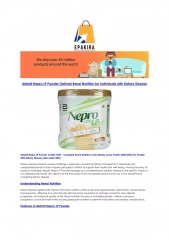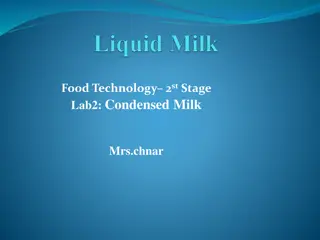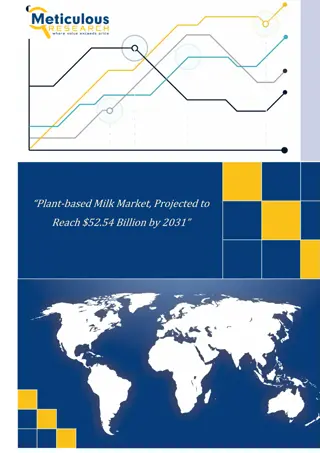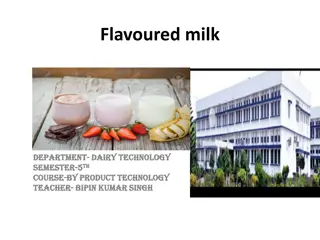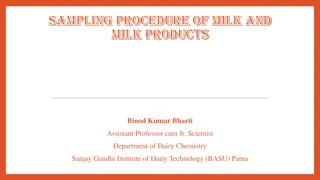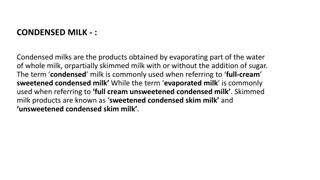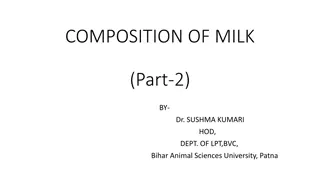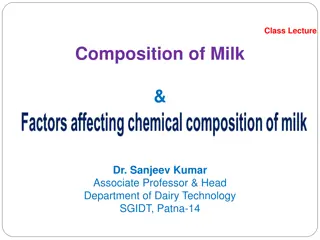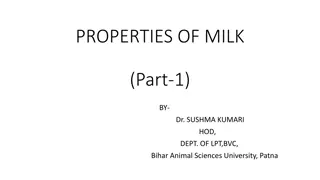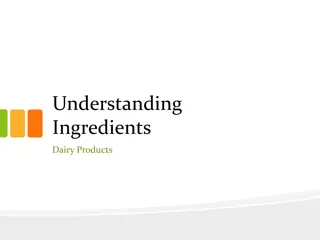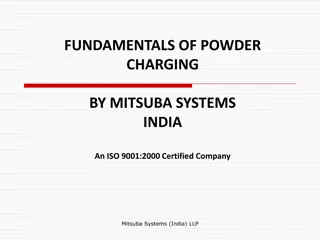Factors Affecting Bulk Density of Milk Powder
Bulk density of milk powder, a crucial property in production, is influenced by factors like the drying method, particle shape, moisture content, and processing conditions. Roller-dried powder tends to have lower density compared to spray-dried powder due to particle shapes and voids. Factors such as protein content, fat level, temperature, and atomizer type also play a role in determining the bulk density of milk powder. Understanding these factors is essential for optimizing the production process and product quality.
Download Presentation

Please find below an Image/Link to download the presentation.
The content on the website is provided AS IS for your information and personal use only. It may not be sold, licensed, or shared on other websites without obtaining consent from the author. Download presentation by click this link. If you encounter any issues during the download, it is possible that the publisher has removed the file from their server.
E N D
Presentation Transcript
Factors Affecting Bulk Density of Milk Powder Dr. J. Badshah University Professor cum - Chief Scientist Dairy Engineering Department Sanjay Gandhi Institute of Dairy Science & Technology, Jagdeopath, Patna (Bihar Animal Sciences University, Patna)
Bulk Density of Powder Bulk Density Mass per unit volume . Also termed as packing density or apparent density, unit= gm/ml Fixed weight is taken and volume occupied is to be found out and B.D. evaluated in gm/ml without tapping. This is poured bulk density as per the size of particles. Loose B.D. = Tapping for 10 times. Tapped B.D. = Tapping for 100 times (More reliable and consistent) Tapped to extreme density = tapping is done for 1250 times. Packaging, transportation cost and storage space are influenced. Low B.D powder requires larger volume to pack so total volume during transportation will be more per unit weight. So transportation cost increases. Functional property also influenced by this basic property e.g. reconstitution is rapid by lighter powder as water can easily entre inside particle.
Factors Affecting Bulk Density of Powder Roller dried have low BD than spray dried powder particles. In roller dried BD mainly depends on fitness of milling and grinding ranging from 0.3-0.5 gm/ml due to irregular shape particles forming voids or interstitial space. Spray dried powder has higher BD due to uniform shapes and close packing of particles resulting lesser voids among the particles. However, the particle density of individual particles is less in case of spray drying than that in roller drying because there is more entrapped air in spray dried particles and particles of roller dried particles are compact. In instant powder, random fusing of particle gives irregular shape so more voids left and agglomerates are porous in nature (rewet powder) in conventional dryer resulting in low BD. The Straight through may have slight higher bulk density than conventional. In the first stage of drying the particle size is decided but final shape of particle is decided in second stage depending on temperature difference. So higher TS can be used to have high bulk density. If the crust is formed due to high temperature difference between air and particle, the vapour is trapped inside the crust and vapour pressure increases. With high TS, the vapour going out is replaced by less air and bulk density of particles are higher and vice versa. If vapour pressure inside the particle is very high and cause bulging effect (i.e. expansion of particle size) then powder become lighter with less B.D. B.D. of spray dried=0.5-0.8 gm/ml Class ppt 3
Factors Affecting Bulk Density of powder Rewetted powder process is expected to have lower bulk density than that of powder from which it is made. High Protein and low fat causes whipping. Foaming ability enhances resulted in low B.D. Nature composition more denatured WP more foaming as WP give good whipping and results in Low B.D. Feed concentration is high i.e. TS high means less foaming and more viscosity also less entrapped air results in high B.D. Feed temperature is high temp means low foaming results in low B.D. Preheating- denaturation of WP = high denaturation less foaming Type of atomizer : Nozzle atomizer = less entrapped air than disc type atomizer but disc type can use high concentrated milk so effect of type of atomizer is not much.
Factors Affecting B. D. of Powder..contd. A new atomizer- steam hustling ( S vanes) reduces chances of air incorporation. Higher the air in feed = higher air in the product= low B.D. Feed viscosity= coarse particle= larger size Outlet temp lower temp =higher moisture Fine returns to increase dispersibility and facilitate agglomeration high fines = more agglomeration B.D. is affected by two main factors 1) Occluded air in pores, 2) Interstitial air between space of particles


